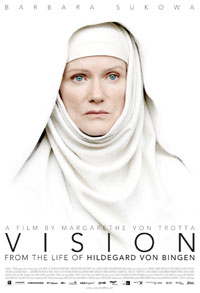Vision – From the Life of Hildegard von Bingen

Ghoshen’s review on the film by Margarethe von Trotta.
‘Vision’ is a biopic of Hildegard of Bingen who was a 12th-century Benedictine nun in what is now Germany. It was made in 2009 by Margarethe von Trotta, who is probably best known for her 1986 film ‘Rosa Luxemburg’, and stars Barbara Sukova.
Hildegard was one of the most significant people in the history of Christian monasticism, perhaps the most important woman, and is considered a saint by “some branches of the Catholic church” – I am unsure exactly what that means.
History tells us that, in addition to being the abbess of a monastery that she founded, Hildegard was a writer, composer, poet, philosopher, healer, visionary mystic and polymath.
Hildegard is likely to be of interest to sannyasins for three reasons. First, she was a mystic and a mystic in ways that many of us can understand and relate to. Her theology came from her visions, not from interpretation of the Bible. Second, she was a rebel – a rebel who courted great danger in revealing her mysticism and visions. In her era, lower-ranking people in the church and especially women were not expected to have such experiences and might well be branded as being in the control of the devil for claiming to do so. Third, in a time of great asceticism when monks commonly indulged in self-flagellation, Hildegard pushed hard and effectively for a more positive and self-loving way of life in the monasteries.
I have long enjoyed learning about the lives of saints, but have focused mostly on Eastern ones. It took my partner to prompt me to watch ‘Vision’ and I am glad I did so although that was more to learn about Hildegard than to enjoy the movie itself.
While Hildegard is a fascinating subject, this film gives only a very narrow view into her life. It does a fine job of depicting the times in which she lived and, in particular, the strict hierarchies of the church and its tight intermesh with the aristocracy. It also provides a beautiful illustration of her daily life, showing, for example, her work with healing plants and her close relationship with a novice.
The most dramatic parts of the film tell how, against the odds, the church came to recognize her as special and let her flourish – although always while keeping close reins on her. Ultimately she came to the attention of the pope whose approval gave great weight to her writings but that was only after many struggles and threats of excommunication. We also see her breaking away from the monastery she first joined in order to create a new one for herself and her nuns, a move that drove them into poverty and great hardship.
‘Vision’ says nothing directly of her mystical experiences except for one rather cheesy attempt – but, okay, that would be hard to do in film. More unfortunately it does not tell us anything about her writings and cuts off at the point where she goes out to travel and preach (which was perhaps unprecedented for a woman).
In summary, the movie is a good introduction to a remarkable and fascinating being but leaves one wanting much more.
Review by Ghoshen, Osho News
Relief: St. Hildegard of Bingen depicted on a gilded altarpiece inside the Rochuskapelle, a church in the town of Bingen am Rhein, Germany (CNS photo/courtesy of KNA)
A beautiful book in German about the saint, unfortunately not translated in English: Hildegard von Bingen. Ein Leben im Licht: Biographie by Heike Koschyk
Hildegard’s compositions on CD: Hildegard von Bingen: Canticles of Ecstasy
composed c. 1151. It is the earliest morality play by more than a century, and the only Medieval musical drama to survive with an attribution for both the text and the music.
- Log in to post comments
- 84 views
